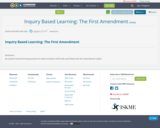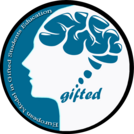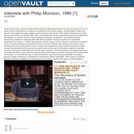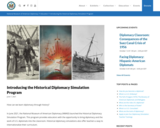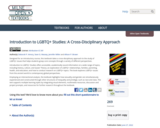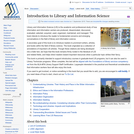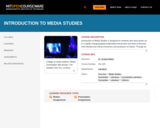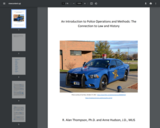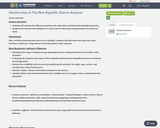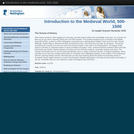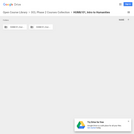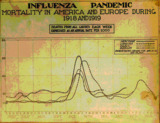
Title: Information Literacy Throughout HistoryGrade: 11th Grade HistoryOverall Goal: This lesson will be for 11th grade U.S. History students. It will teach them how to analyze and understand documents and news sources. The students will play a board of the game will take students through different time periods of U.S. History, starting with the Pilgrim Era and ending with modern day. The student will draw a card and answer a question written on the card pertaining to the era of U.S. History they are in on the board. The questions will all involve the students being given a quote to analyze, or a QR code they can scan that will take them to a historical document that they must briefly examine. If they answer the question on the card correctly, the student will get to roll the die and advance that many spaces. The first student to get through the modern era will win the game. The students will write an essay at the end of the lesson plan. The goal of this lesson plan will be for the students to analyze documents based on the event that relates to the prompt they are given. They will also be assessed on their ability to correctly cite these sources, as well as being able to decipher between good and bad sources of information. StandardsLearning ObjectivesAssessment3b. Students evaluate the accuracy, perspective, credibility and relevance of information, media, data or other resources. USH.9.4 Explain issues and problems of the past by analyzing the interests and viewpoints of those involved.Students will be able to analyze the quality and credibility of websites.Students will be able to critically analyze the intentions of commercial websites.Students will be to apply different search strategies to increase the accuracy and relevance of online search results.Students will be able to analyze the credibility of news sources and articlesPick a historical article to write an essay on and analyze the biases presented in that article. Key Terms & Definitions: Information Literacy: The ability to identify, find, evaluate, and use information effectivelyBias: a belief held by the author of a document that might impact the information they presentViewpoint: a person’s point of viewRelevance: something that is closely connected or important to a topicCite: evidence for the argument or statement that a person is attempting to make.Era: a specific period of timeAmerican Revolution: 1765- 1783. The Thirteen Colonies gain independence from Great Britain.Civil War and Reconstruction: 1861- 1877. The South secedes from the Union and eventually loses the Civil War. Then, the nation rebuilds and restructures without slavery.World War II: 1939- 1945: Hitler creates the Axis Powers and starts the Holocaust. The Allied Powers get involved and eventually end the war with the United States dropping nuclear bombs on Japan.21st Century: the era that is currently taking place. 2000- present. Lesson Introduction (Hook, Grabber):https://www.youtube.com/watch?v=u8QMqNU9ShA This is a clip from a Jimmy Fallon skit about Donald Trump and “fake news”. This will get students engaged with the material because it’s funny and relates the content to things that are going on right now. The lesson will cover different sorts of news and historical documents throughout U.S. History, so getting students to see that this is still relevant and important for them to be able to recognize today is very important. Students will have a prior knowledge of who Donald Trump is and that he is obsessed with fake news, and they will know that fake, sensationalized news is a big problem for people nowadays because there are a lot of unreliable information and websites online. Students will also have a basic knowledge of U.S. History and they will know major eras in history, for example they will know about the Revolutionary War, the Progressive Era, World War II. etc. Lesson Main: The board game is a game where students will “travel through history”. The board is split into four sections which are the Revolutionary War, the Civil War, World War Two, and the 21st century. The students begin in the Revolutionary War era. Each era has 5 spaces they can land on. In each era they will have to answer questions about that era. A question could be something like “When did the Revolutionary War start?”. Questions could also be something where students are given a QR code to scan and it will take them to a political cartoon and they will have to answer the question “Do think this political cartoon was made by the British or the Americans?”. This will be the same throughout all sections of the board. Students will be given either a trivia question about the era or a document/political cartoon/quote from the era that they have to answer. If they answer correctly, the student can roll a dice and move forward that number of spaces. If they get the question wrong then they will stay at the same space. The game ends when a player gets to the finish spot first.This will be beneficial for students because most times, history is “written by the winner”. That means that a lot of groups throughout history have had their viewpoint erased and now we are only told the people in power’s perspective. This board game teaches students to skim a document or read a quote and try to understand what viewpoints and biases are represented in that document. These are our learning objectives so, the board game has students accomplish these learning objectives. Also, with the inclusion of the 21st century section, students will meet the ISTE objectives because they will analyzing documents and the reliability of news articles from our modern era. This not only meets the ISTE standard, but it also shows the students that what was taught in the board game is still important and relevant to them today, even though they mainly examined documents from the past. Lesson Ending: At the end of the lesson, students will reconvene with the teacher and their assessment will be explained. The assessment will be an essay over a historical document of the students choosing. The document can be a piece of writing, political cartoon, or any other historical document written before 1970 that they believe they can write a 3 page essay about. The document should have been made before 1970 because that shows that the students can analyze historical documents and this is for a history class. The paper should be summarizing the document and then analyzing the viewpoint and biases of the document’s creator, then explaining how those biases impacted the way the author wrote the essay and the arguments the author presented. Additionally, since “history is usually written by the winner”, outstanding essays will also explain whose opinion or voice on their topic might be left out, or explain a person or group who might disagree with the author’s point of view. Assigning students an essay to show that they know how to analyze sources is very valuable because essays force them to provide their own opinions about how the topic of the essay is or is not reliable or biased. This makes it very easy to the teacher to ensure that the students fully understand how to analyze documents and how to coherently convey their analysis in writing. The essay assignment will be given in class but it should be written at home. Assessment Rubric: 1234FormatThe essay is not in size 12 Times New Roman Font, not in MLA format, citations are totally incorrect or non-existent, there are many grammatical errors, the essay is not 3 pagesThey essay is not in size 12 Times New Roman font, there are errors in MLA format, citations are mostly incorrect, there are many grammatical errors, the essay is not 3 pages longThe essay is in size 12 Times New Roman font, MLA format, citations are mostly correct, there are few grammatical errors, the essay is 3 pages longThe essay is in size 12 Times New Roman font, written in MLA format, citations are correct, there are no grammatical errors, the essay is 3 pages longSummaryStudents did not summarize their document, cited their source incorrectly, and their document was not written before 1970Students spent a paragraph or less summarizing their document, cited their source incorrectly, OR their document was not written before 1970Students summarized their article briefly, cited their source correctly, and their document was made before 1970Students accurately summarized their historical document, cited their source correctly, and their document was made before 1970AnalysisStudents do not analyze their documents viewpoint and biases or they completely misinterpret the documentStudents attempt to analyze their document’s viewpoint and biases but get some facts wrongStudents correctly analyze their document’s viewpoint and biasesStudents correctly analyze their document’s viewpoint, biases, and explain whose opinion is left out of the document Resources / Artifacts: These should link to things you’ve actually created in support of the lesson. They should also be reference above during the lesson (as shown above). Each team member should create one artifact to support this lessons. Examples could include: (Leah) Screencast: https://youtu.be/7VgNxagmXhI(Konnor) Infographic: https://create.piktochart.com/infographic/saved/28152960#(Konnor) Board game tutorial video: https://www.youtube.com/watch?v=LpRb_awf0-s Differentiation: Scenario 1 Your class is composed of 30 students with a wide range of abilities and interests. Through careful assessment, you learn that your students range from those who read at or above grade level to those who struggle to read anything at all. The same goes for class discussions, you have students who are eagerly participate in classroom discussions, and a group of students who struggle to express their ideas orally. Also, you have 5 students whose native language is not English: they speak Spanish, Chinese, Korean, Arabic, and German at home. Two students do not have internet at home, and they usually have trouble completing their homework on time if it requires using online resources. TaskIn your lesson plan, you are asked to address differentiation possibilities for ability levels, different language needs, and a diverse range of student learners. Based on the given scenario, discuss and write up 4-5 ideas for differentiation, including certain technology tools or resources you can use to help your students learn the content of your DC lesson. Each student is provided with a school-owned iPad so if they don’t know english or have limited english abilities they can use a translation app like Google Translate to translate the question so they can understand it.Additionally, for the ESL or EFL students, the teacher can use Newsela to help them understand documents and articles they might be reading because Newsela will change sources to fit a student’s reading level.The iPads provided will also help the students who don’t have internet at home or don’t have access to smartphones because they will be able to scan QR codes in the board game and have a device that they can type an essay with.For the students who can’t read, the teacher can be available after class or after school to meet with them and go through the readings very in-depth to make sure the student gets the information they need. Additionally, the teacher can incorporate as many pictures and videos in the in-class presentation as possible to ensure that the student can follow along in class as well as they can.For the students who struggle to express themselves orally, the teacher can use Nearpod for presentations so the students can type out their answers instead of having to present them verbally. Anticipated Difficulties: One difficulty we anticipate is students not having access to their phones as this will take place during class so we will have iPads available for students to use to perform the webquests. Another difficulty we anticipate students having is not being able to get a QR code or some other piece of technology to work, so we made an excess of questions for each section of the board so students won’t run out of questions to ask.
- Subject:
- U.S. History
- Material Type:
- Lesson Plan
- Author:
- Leah Routson
- Date Added:
- 03/21/2018

